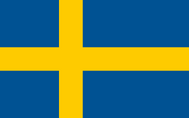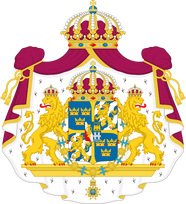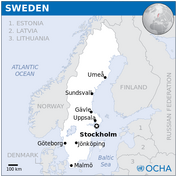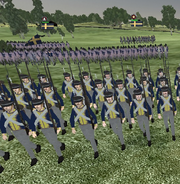

Sweden (1210-present) is a parliamentary constitutional monarchy located in the Scandinavian historical region of northern Europe. Consolidated with the coronation of Eric X in 1210, Sweden proceeded to become a powerful empire that included present-day Sweden, central Norway, Denmark, Finland, Estonia, the Pomerania region of Germany, and parts of Russia and Poland. Sweden also had a colony in Delaware in the United States. It fought its last war in 1814, and today it continues a policy of neutrality.
History[]

Map of Sweden
Sweden was initially a large land divided between many Viking lords, and only in 1210 did Eric X of Sweden emerge as the leader of the whole country. He was confirmed as King by the Papal States, and Sweden consolidated into a half of the Scandinavian region. Sweden was incorporated into the Kalmar Union from 1397 to 1471, when Sten Sture won independence from Denmark at the Battle of Brunkeberg. Unfortunately, the death of Sture forced Sweden to rejoin the Kalmar Union, which it joined until 1521, when it won independence due to the efforts of King Gustav I of Sweden. In the 1600s it waged war with Russia, Poland-Lithuania, and Denmark under King Gustavus Adolphus, who annexed Estonia and Finland.
Gustavus Adolphus led Sweden into a golden age from 1626, when it joined the Protestant Union during the Thirty Years War. The young Gustavus commanded cavalry forces in many battles with his traditional enemies in addition to the Holy Roman Empie and Catholic League, whose forces were defeated at the First Battle of Breitenfeld and the Battle of Lutzen, where Gustavus died in 1632. After his death, Sweden remained in the war and conquered central Norway from Denmark in 1645. By the terms of the Treaty of Westphalia in 1648, Sweden gained central Norway in addition to keeping Estonia, Finland, and a slice of territory in northern Germany, which became Swedish Pommerania.

Swedish army in 1700
The Swedes defended and expanded their lands during the Northern Wars of the mid-17th century, although they lost the Scanian War of the 1670s against Denmark and their United Provinces (Dutch) allies. Sweden suffered their worst losses and best victories during the Great Northern War (1700-1721), where they took on a coalition of the Russian Empire, Poland-Lithuania, Denmark, Prussia, and Saxony, with the result of crushing victories at the Battle of Narva and the Battle of Kliszow but crushing defeats at Poltava, Osel, and Grengam. The end result was the loss of central Norway to Denmark and their lands in Estonia and Russia to the Russian Empire.

Swedish troops at the Battle of Magdeburg, Napoleonic Wars
In the aftermath of the war, Sweden still remained a strong nation, fighting Prussia in the Seven Years' War of 1756-1763. They also fought Russia in 1788-1792, but they were defeated due to the efforts of the Russian Navy's admiral John Paul Jones, a former hero of the American Revolutionary War. Sweden allied with Russia during the War of the Third Coalition against France in 1805-1806, but in 1809, Russia settled old scores by launching a surprise attack on Finland and capturing Aabo, driving the Swedes out. They later renewed their alliance, and were powerless to stop Sweden from taking Norway from Denmark in 1814.
As Sweden-Norway, ruled by the French House of Bernadotte (descended from Napoleon's marshal Jean-Baptiste Bernadotte, later Charles XIV John of Sweden), Sweden was a state that followed a policy of neutrality. Some volunteers fought for Oranje, Transvaal, and the Orange Free State during the Second Boer War of 1899-1902. Sweden remains a constitutional monarchy, following a policy of neutrality.

